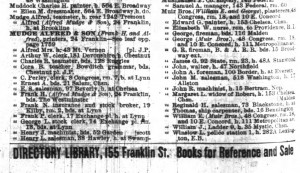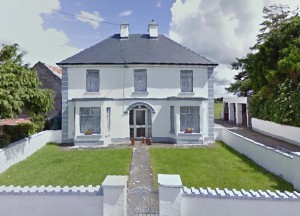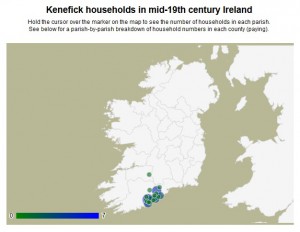[Editor’s note: Katrina Fahy has written a number of posts on researching her Scottish, Irish, and German ancestors. Some of her techniques – and successes – are excerpted below.]
 From Finding William Muir: When I began working as a genealogist, my mother expressed great interest in learning more about her father’s family: the Muirs. While she had much information on her mother’s side of the family, which was quite large, she knew little about her father’s side of the family beyond her grandparents, so I began there…
From Finding William Muir: When I began working as a genealogist, my mother expressed great interest in learning more about her father’s family: the Muirs. While she had much information on her mother’s side of the family, which was quite large, she knew little about her father’s side of the family beyond her grandparents, so I began there…
Though I could not locate a birth record for William Muir, I was able to find him with his family in the 1860 Federal Census living in Charlestown in (what was then) Middlesex County; aged 3, he was enumerated with his father Robert Muir (age 30), mother Margaret (31), and brother Edward G. Muir (4 months).
Sadly, Robert Muir died in 1867 at the age of 37, but even before then the records on the Muirs had dried up. William Muir and his family are nowhere to be found in the 1865 Massachusetts State Census, nor was I able to locate William on any census record prior to 1910…
Having run out of other explanations, I was convinced that William Muir was still living in Charlestown, and that he was simply left off or incorrectly enumerated on the census. Therefore, the only way to determine where in Charlestown William Muir was living was by checking the Boston City Directory. Beginning in 1892, the year my great-grandfather was born, I followed William Muir, fireman, through the directories until I found him living at 35 Mystic Street in Charlestown in the 1900 and 1901 directories…

From Finding the Fahys in Ireland: I recently went to Ireland to visit my dad’s family. Having investigated my grandmother’s ancestry on a previous trip, I wanted to focus this time on learning more about the Fahys.
Thomas Fahy, my paternal grandfather, died in 1983, when my dad was 23. Beyond that, I was able to glean a bit more from my dad, grandmother, and uncles:
- Thomas was born in December 1914 in Tuam, County Galway, and was the oldest child in his family.
- Thomas’s parents were Matthew Fahy and either Julia Howley or Sarah Fahy.
- Matthew Fahy was born around 1880, probably in Tuam.
- The farm where my dad grew up was once owned by Thomas Fahy’s unmarried uncles, and was given to him in the 1940s or early 1950s.
- The house in which my father grew up was built in the 1940s and was not the original farmhouse; the original house was set farther back on the property…
I used my subscription to RootsIreland.ie to search for birth and baptism records for a Matthew Fahy born in County Galway around 1880. Though I could not find a baptism record for a Matthew Fahy born in Tuam, I did find a Matthew Fahy baptized in Lackagh, County Galway, on 8 August 1886, son of John Fahy and Ellen Cooly. What struck me was the listed address for Matthew Fahy: Grange Castle. My dad grew up in Grange, and right down the road from my grandmother’s house is the ruin of a castle. A quick search of castles in County Galway revealed that Grange Castle is in fact the ruin near my grandmother’s house. My dad showed me the location of the original farmhouse when we were visiting, which was much closer to Grange Castle than the current house. Perhaps Matthew was born in Grange rather than Tuam…
I still need the birth and marriage records from the General Register Office to confirm my findings. But the family stories I was told, though lacking in dates, allowed me to weed through the many Fahys of County Galway and pointed the way to these probable ancestors.
 From Why did they go back?: My great-great-grandmother, Margaret Kenefick, was born in Boston on 11 February 1857, the daughter of Irish immigrants Thomas and Mary Kenefick. When I began searching for the family in Boston, I turned to the 1860 Census, but was surprised when I could not locate the Keneficks in Massachusetts…
From Why did they go back?: My great-great-grandmother, Margaret Kenefick, was born in Boston on 11 February 1857, the daughter of Irish immigrants Thomas and Mary Kenefick. When I began searching for the family in Boston, I turned to the 1860 Census, but was surprised when I could not locate the Keneficks in Massachusetts…
Fortunately, the family is listed in the 1870 Census, living in Ward 2 of Boston. Thomas and Mary Kenefick have five children: John, Margaret, Thomas, Michael, and Mary. What caught my attention were the birthplaces listed for the Kenefick children. While Margaret, Thomas, and Mary list their birthplace as Massachusetts, John (age 17) and Michael (age 8) are listed as having been born in Ireland. As John is the oldest, it was unsurprising that he might have been born in Ireland, and then emigrated with his parents; however, Michael is one of the younger children. Was Michael’s birth information incorrect, or does the disappearance of the Kenefick family from census records and city directories indicate that they returned to Ireland for a time?
…Perhaps Thomas Kenefick took his family back to Ireland for economic reasons; according to a Kenefick family website, there was a Kenifeck family (alternate spelling) who were woolen drapers in the city of Cork throughout the eighteenth and nineteenth centuries. Though the potato famine had devastated much of Ireland, I briefly looked into the economic history of the City of Cork to see if the area had perhaps bounced back more quickly than the rest of the country.
The History of Cork provides a great deal of insight into the history of Cork throughout the Potato Famine and its aftermath. In the latter part of the nineteenth century, it appears that the city tried to revitalize its economy, but was largely unsuccessful due to competition from foreign markets. Therefore, it seems unlikely that Thomas Kenefick and his family would have returned to Ireland for economic opportunities. Perhaps family circumstances brought the Keneficks back to Ireland. My next step is to look at Irish Calendars of Wills and Administrations, 1858-1920, available on FamilySearch.org, and Irish Petty Sessions Court Registers, 1928-1912, available at Find My Past, for references to the Kenefick and Woods families in Cork that may explain why the family needed to return to Ireland.
Katrina, do you have any tips for researching Scots-Irish who came to New Jersey and Pennsylvania in the mid-1600’s.
Like Carole, I am working on a genealogy that involves a Scotch-Irish family. They are believed to have emigrated from Northern Ireland to the Carolinas in the 1730s or 1740s. Would the database you referred to be helpful in researching Protestants in that era?
I, too, am looking for data on a Scots-Irish family in rural New York in the early 1700s, so no censuses or city directories. So far, I have not had any success in locating anything in Ireland.
I found an ancestor who came over with a husband and infant in 1887. They had a second child in Lynn, MA in 1888. The husband died in 1890 and the mother and children returned to Waterford soon after. Their return may have been to use a family support network back in Ireland (her father owned a pub in Waterford) to replace the support of her deceased husband. This was probably better that than relying on charity in America at the time. I wonder how many immigrants went back for a similar reason?
According to the “Harvard Encyclopedia of American Ethnic Groups”, which was published in the 1970’s, about 25% of immigrants went back to Europe. It may have been for family reasons, or because economic conditions had improved in the old country, or because they found it too hard to make a living here. My French-Canadian ancestors went to Chicago, went back to Quebec, then re- emigrated to Rhode Island. I surmise that they came to make a quick buck, and then return to Quebec to buy property. When that didn’t work out, they returned to the U.S. for good.
Hi Katrina,
Love reading your posts, doesn’t hurt that I’ve got Fahy in the family from Galway (Lisheen/ Glenamaddy, Mothers side) and Kenefick from Cork (fathers side Clonakilty/Bandon)
Here? Roslindale, West Roxbury and Dedham? yes, yes, yes. PJ Bernard